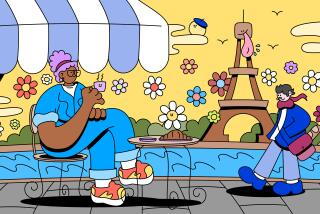Harvesting Tips on Trips From 3 Savvy Newsletters
- Share via
Monday: Check Continental OnePass mileage balance and scan Internet for discounted air fares.
Tuesday: Toss away that dubious travel-agent credential/discount offer.
Wednesday: For budget-busting splurge over long weekend, choose between Timberhill Ranch in Sonoma County and Rancho de San Juan near Santa Fe. Meanwhile, spend night at La Quinta Resort near Palm Springs and steal toiletries.
The perfectly well-briefed traveler doesn’t exist, but if one did, his or her date book might read like this. These tips are harvested from Consumer Reports Travel Letter, Inside Flyer and Andrew Harper’s Hideaway Report, a trio of respected travel monthlies that each came out recently with lists of industry winners or losers.
Not all the advice in these lists is practical for everyone. (Not everyone, for instance, would spend $435 nightly to enjoy the highly touted comforts of La Scalinatella hotel on the Italian isle of Capri.) But there’s a lot of good intelligence here for anyone who wants to travel wisely. For instance:
In the January issue of Consumer Reports Travel Letter (CRTL), the “best bets” of 1999 begin with Internet deals--discounts that airlines and others offer only to online customers, in part because online transactions cost the carriers less in overhead. The discounts often vanish if you see them on screen and try to book them by phone. And remember that no matter how comprehensive those airline Web sites may seem, they’re designed to funnel your business to one airline. More than one consumer, intoxicated by the bookings to be made with a keystroke, has forgotten that there’s still no substitute for comparison shopping.
CRTL also likes Hawaii and Asia now as destinations (thanks to price cuts due to economic crises), recommends you consider alternative airports (Chicago’s Midway rather than O’Hare, for instance) and hopefully forecasts ’99 as the year in which steadily climbing U.S. lodging costs will finally level off.
The editors also point out the usefulness of hotel-room brokers and airline-ticket discount agencies (often dubbed “consolidators”), both of which advertise widely with toll-free phone numbers. And maybe, say those editors, the cruise business is ripe for price cuts too. At least eight big new ships will be introduced in 1999, and nobody’s certain that demand will keep pace with supply.
Any bad deals? The CRTL people have a separate list of those. Unsolicited travel certificates promising improbable deals have been disappointing inexperienced travelers for many years now, as have marketing campaigns that sell supposed travel-agent credentials (and purported discounts) to consumers with virtually no specialized training. Rental car company pitches to sell collision- or loss-damage waiver coverage on domestic car rentals get CRTL scorn too, since your regular car insurance or credit card may already cover you. (This is a trickier question on foreign rentals.)
And of course, no such list would be complete without the Cal Ripken Jr. of bad travel deals, enduring year after year: the full-fare, unrestricted coach ticket. Designed to exploit last-minute business travelers, it virtually ensures that you’ll be seated next to someone who paid less than half what you did.
And on the subject of airlines, up steps Inside Flyer magazine, the bible of mileage junkies, with its February issue and its 11th annual Freddie Awards. Based on votes from 82,480 of the magazine’s frequent-flying readers, the prizes for best overall frequent-flier program, best Web site and best customer service went to Continental’s OnePass program. The top hotel frequent-guest program was Marriott Rewards, narrowly edging out Hyatt Gold Passport.
The two dozen favorite lodgings named in the December issue of Andrew Harper’s Hideaway Report never figure in frequent-guest program contests because they serve such a small group of customers--basically, those who spend and demand the most.
The Sun Valley, Idaho-based Hideaway Report’s “hideaway of the year” honors depend on the choice of the newsletter’s publishers, who say they travel under assumed names and take no discounts or freebies. Their favorites are intimate, comfortable lodgings with good service and noncommercial character, usually in uncitified settings.
Their list of top hideaways in the U.S. includes Woodlands Resort (a 19-unit, 42-acre estate northwest of Charleston, S.C., $325 and up per night), Blantyre (a 23-unit, 85-acre manor property near Lenox, Mass., $350 and up, closed in winter), Timberhill Ranch (15 cottages on 80 hilly acres along the Sonoma County coast, $395 and up) and Rancho de San Juan (11 units on 225 acres in the New Mexico desert 40 minutes northwest of Santa Fe, $195 and up).
The Hideaway Report’s list also includes two Mexican hotels: Las Alamandas (an 11-unit beachfront retreat two hours’ drive from Puerto Vallarta, $780 and up) and Casa de Sierra Nevada (36 units in the colonial town of San Miguel de Allende, $230 and up).
The Hideaway Report also singles out the La Quinta Resort & Club near Palm Springs for the best package of toiletries and names Canyon Villa in Sedona, Ariz., as its favorite B&B.;
For subscription information: Consumer Reports Travel Letter, telephone (800) 234-1970; Inside Flyer, tel. (800) 767-8896; Andrew Harper’s Hideaway Report, tel. (800) 235-9622.
Christopher Reynolds travels anonymously at the newspaper’s expense, accepting no special discounts or subsidized trips. He welcomes comments and suggestions, but cannot respond individually to letters and calls. Write Travel Insider, Los Angeles Times, Times Mirror Square, Los Angeles 90053 or e-mail chris.reynolds@latimes.com.
More to Read
Sign up for The Wild
We’ll help you find the best places to hike, bike and run, as well as the perfect silent spots for meditation and yoga.
You may occasionally receive promotional content from the Los Angeles Times.







